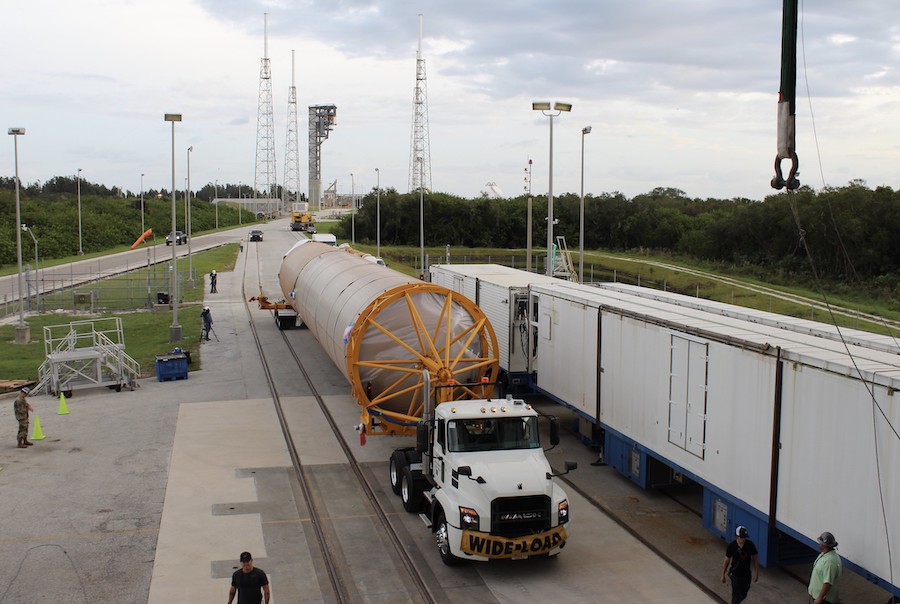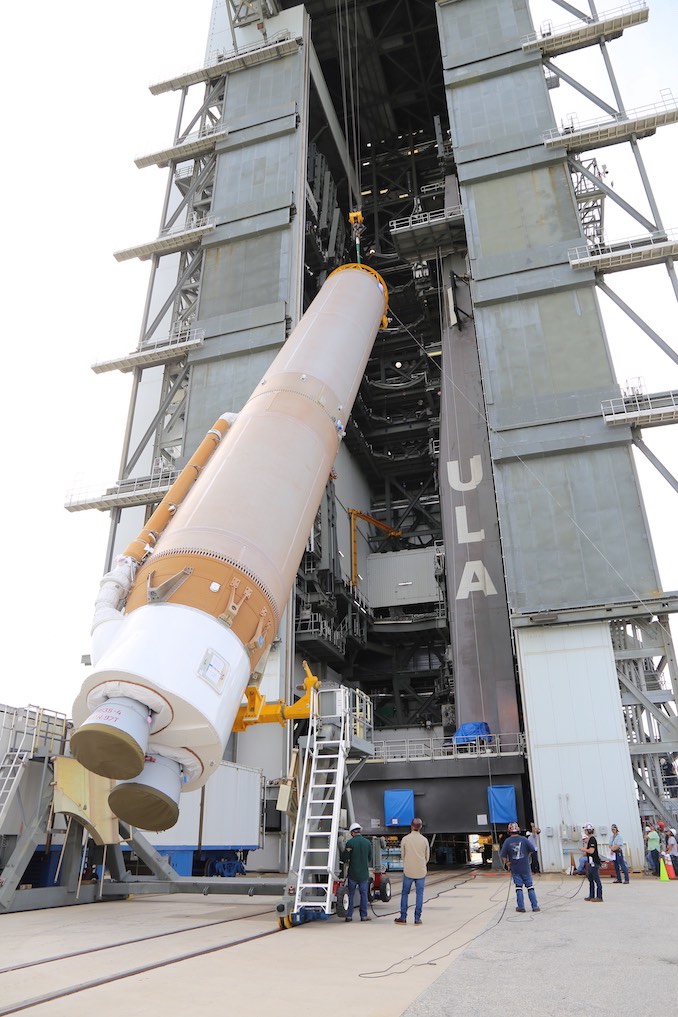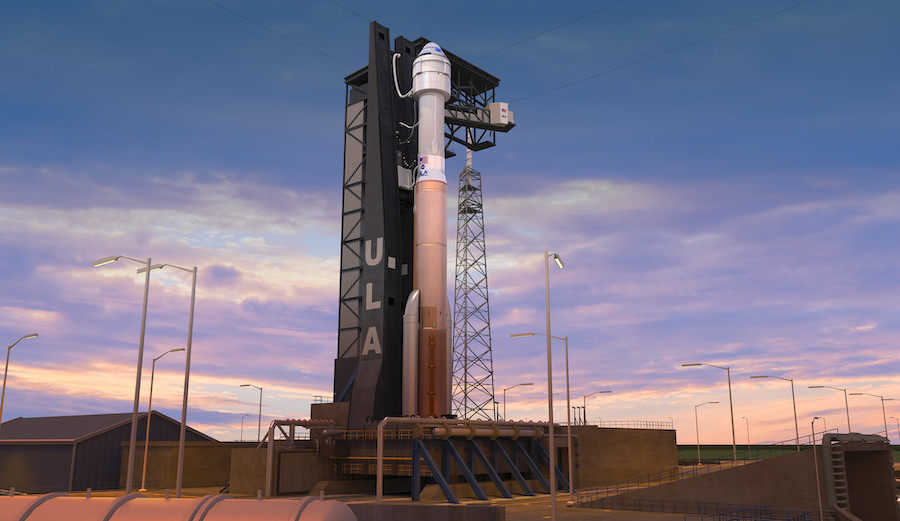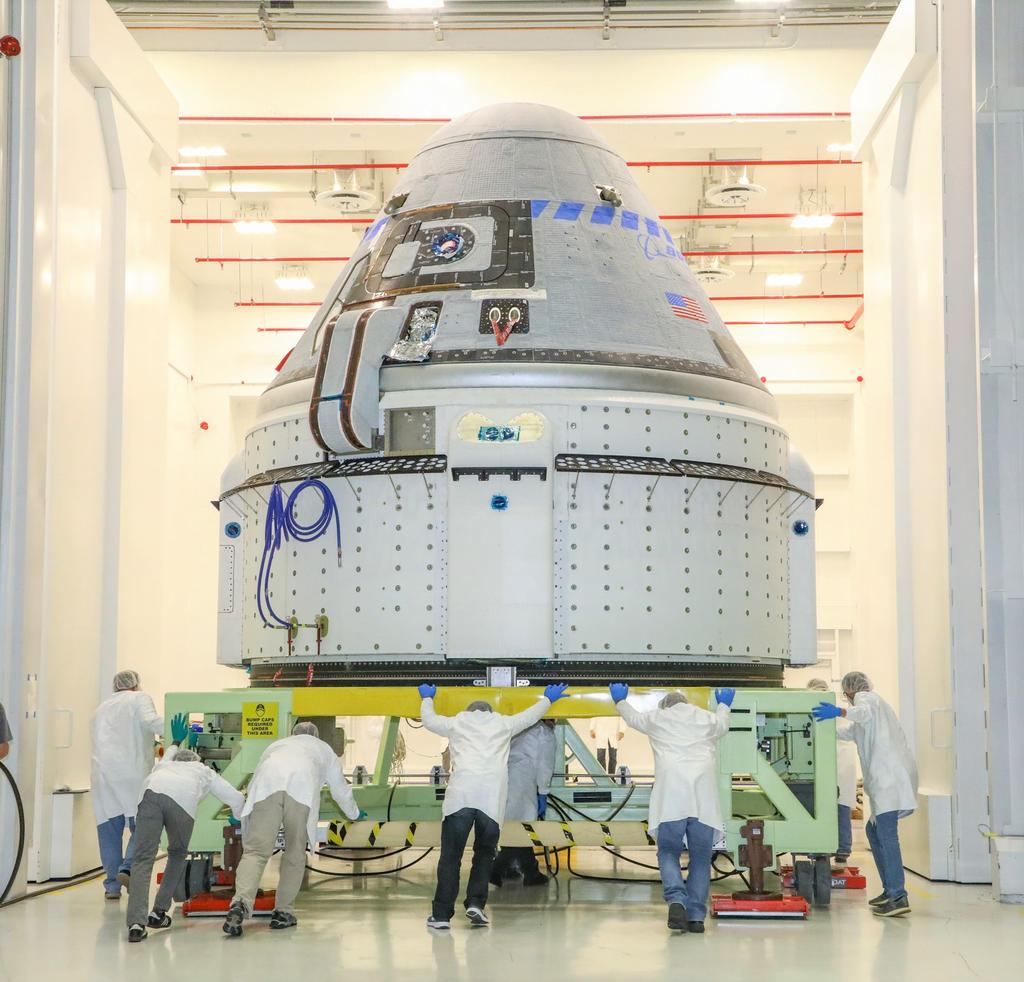ULA begins stacking unique Atlas 5 rocket for Starliner test flight – Spaceflight Now

The stacking of a United Launch Alliance Atlas 5 rocket this week at Cape Canaveral signals the start of a busy six-week campaign to ready ULA’s trusty workhorse launcher for its debut in a new human-rated configuration in mid-December.
“There are certainly some unique and very exciting things about this particular vehicle,” said Caleb Weiss, ULA’s mission manager for the Starliner program.
The “firsts” for the Atlas 5’s next launch include the rocket’s first flight without a payload fairing, and the first use of a dual-engine Centaur upper stage on the Atlas 5. The Atlas 5 has flown 80 times to date, amassing a flawless success record carrying U.S. military, NASA and commercial payloads into orbit.
But launching astronauts comes with its own set of requirements, including new computers to monitor the rocket’s performance, and if required, trigger an abort to ensure the crew can escape the launcher in an emergency.
“Electrically, one of the unique things about this mission is that the launch vehicle and spacecraft are going to be talking to each other,” Weiss said in a recent interview. “We normally don’t have that. They will be sharing data throughout (the) flight.”

The Starliner spacecraft, developed by Boeing under a $4.2 billion commercial crew contract with NASA, will be the heaviest payload ever launched by an Atlas 5 rocket.
“I think it is absolutely more complex (than a typical ULA mission), and the reason is that, even though the mechanical interface may seem simple because it’s a bolted ring interface, to get to that bolted ring interface took a lot of design work and analysis to make sure that it could handle the flight loads,” Weiss told Spaceflight Now in an interview. “The aero skirt obviously has all the aerodynamic analysis behind it, and it also has doors in the bottom that will open in the event of an abort. That way, the abort engines have a place to vent so you don’t build up pressure in that cavity in an abort. So there’s certainly a lot of capability that’s built in just to the structure.”
ULA ground crews raised the Atlas 5’s first stage upright after sunrise Monday, and a crane carefully positioned the rocket on top of a mobile platform inside the Vertical Integration Facility at Cape Canaveral’s Complex 41 launch pad.
The milestone event, known as Launch Vehicle On Stand in ULA’s parlance, kicks off final assembly of the Atlas 5 rocket that will launch Boeing’s CST-100 Starliner crew capsule on its first space mission. The Starliner’s Orbital Flight Test, or OFT, is scheduled for liftoff Dec. 17 on an unpiloted demonstration of the ship before astronauts fly on the next Starliner spacecraft in 2020.
The Starliner spacecraft will fly in autopilot mode to the International Space Station for a week-long mission to assess the ship’s readiness for crewed flights. At the end of the mission, the capsule will undock and return to Earth for landing under parachutes — and cushioned by airbags — at one of several possible locations in the Western United States.
Boeing’s preferred landing site for the test flight is at White Sands Missile Range in New Mexico.
The Atlas 5’s 107-foot-long (32-meter) bronze first stage is powered by a Russian-made RD-180 engine that burns kerosene and liquid oxygen. On launch day, ULA will load 25,000 gallons of RP-1 kerosene fuel and 49,000 gallons of liquid oxygen into the first stage.
ULA plans to install two Aerojet Rocketdyne solid rocket boosters to the Atlas 5 core stage later this week, then lift the rocket’s Centaur upper stage atop the vehicle. Late last year, technicians mated the Centaur to the Atlas 5’s interstage adapter, which connects the Centaur with the first stage, and the launch vehicle adapter, the structural interface between the rocket and the Starliner crew capsule.
The Centaur, along with the adapters, will be raised at the end of the week on top of the Atlas 5 first stage in a single piece to complete the initial build-up of the launcher inside the VIF at pad 41.
Then comes a series of initial checkouts of the Atlas 5 rocket systems before Boeing’s Starliner spacecraft arrives at the launch pad in mid-November.

In mid-November, Boeing’s team will roll the Starliner spacecraft out of its factory, a former space shuttle hangar at NASA’s Kennedy Space Center, a few miles from the Atlas 5 launch pad.
With the addition of the Starliner capsule, the Atlas 5 rocket will stand 172 feet (52 meters) tall. That’s somewhat shorter than other Atlas 5 configurations, which fly with bulbous payload shrouds to shield satellites during the first few minutes of flight through the thick lower atmosphere.
The Starliner, with its thermal protection coating, does not require a payload fairing during launch.
This week, teams are loading several tons of hydrazine and nitrogen tetroxide propellant into the Starliner spacecraft inside a special fueling area inside the Boeing-run factory adjacent to Kennedy’s towering Vehicle Assembly Building.
Boeing technicians connected the two components of the Starliner spacecraft — the crew module and the service module — last month in preparation for the OFT mission.
After installing the Starliner on the Atlas 5, ULA and Boeing will roll the fully-assembled rocket to pad 41 for a full-up countdown rehearsal. The rocket will ride its mobile platform on rail tracks for the 1,800-foot (550-meter) trip to the pad.
The Integrated Day-of-Launch Test, or IDOLT, is a major exercise for ULA and Boeing ground teams.
The test “will give us the opportunity to deploy the crew access arm and verify all the access tower and arm interfaces with the spacecraft,” Weiss said. “We will fully tank the vehicle, and we will have people out there at the pad that will be simulating day launch operations, just like they will be for a real launch day.
“So they will be in the white room, they’ll open up the hatch of the Starliner,” he said. “They will practice going in and out, loading cargo, configuring Starliner for flight. So it’ll be a really good end-to-end system checkout of all the launch vehicle and spacecraft systems working together, as well as the people who are executing the operations.”

ULA constructed the crew access tower at pad 41 in preparation for Starliner launches. Near the top, a crew access arm provides astronauts with a walkway to board the crew capsule, with a “white room” to connect with the Starliner’s hatch.
Significant changes to the Atlas 5 rocket for crew missions include the Emergency Detection System, a computer that will track key parameters in flight, and command an abort if necessary.
The Atlas 5 carries two EDS processing units for redundancy. The rocket only needs one computer during launch.
The EDS processing units, based on the Atlas 5’s fight-proven INCA computer, will be “monitoring multiple measurements, thousands of times per second, up and down the rocket to look for anything that may appear off-nominal,” Weiss said. “And those boxes would be the ones to tell the spacecraft to abort if it ever detected something across the threshold.”
The EDS computers are located near the top of the Centaur upper stage. Data fed into the computers include “things like rates on the vehicle, accelerations, certain pressures, just various instrumentation across the vehicle that we chose as the critical measurements that could tell us if the vehicle is not performing nominally,” Weiss said.
Starliner’s unpiloted OFT mission will not have an active abort system. The capsule will be fitted with abort engines used during ground qualification testing, and engineers will evaluate the EDS computers’ performance to ensure proper settings for crewed missions.
On missions with astronauts, the Starliner crew could also manually issue an abort command using a handle inside the cockpit.

The Atlas 5’s first launch with the Starliner spacecraft will also be the first to employ a Centaur upper stage with two Aerojet Rocketdyne RL10 engines. The dual-engine Centaur stage previously flew more than 100 times on earlier Atlas rocket variants, most recently in 2004.
“That extra engine does provide the additional thrust to lift that heavy payload to LEO (low Earth orbit,” Weiss said. “It also lets us also let this fly as shallower trajectory, which is more favorable if we had to ever have an abort with the crew on there. So that additional trust lets us design the trajectory in a way that is that optimizes the safety of the crew.”
The RL10 engines will consume super-cold liquid hydrogen and liquid oxygen, cumulatively generating nearly 45,000 pounds of thrust.
ULA and Boeing developed a design fix in 2016 to address aerodynamic problems discovered during wind tunnel testing. A 70-inch-long (1.8-meter) aeroskirt extension is installed on top of the Centaur upper stage, where it will be positioned against the bottom of the Starliner spacecraft during launch.,
“We did have quite a bit of analysis that was done early on in the program, wind tunnel testing, and what that showed us was that really get optimal stability on the vehicle, we wanted to extend the aerodynamic surface of the spacecraft further aft and that’s where we came up with the 70-inch aeroskirt, “Weiss said. “So once we incorporated that change, we went back and did additional wind tunnel testing, and all that came back with an improvement — you can improve the aerodynamics and improve the stability, overall stability of the vehicle.”
The aeroskirt will jettison from the rocket shortly after the Centaur ignites its RL10 engines around five minutes after liftoff, around the same time a payload fairing separates during a standard Atlas 5 launch.

The demands of a crew mission also forced ULA’s launch team to adjust the Atlas 5’s countdown.
The Atlas 5 countdown typically lasts nearly seven hours for a satellite launch. For Starliner missions, the countdown will run nearly 11 hours.
Assuming the OFT launch date remains set for Dec. 17, the Atlas 5 will roll out to pad 41 on Dec. 15 to allow ground teams to configure the rocket for the countdown and sync their schedules for the launch.
For a Dec. 17 launch, the Atlas 5’s liftoff time will be approximately 7:45 a.m. EST (1245 GMT). The launch time is determined by space station’s orbit, and moves around 20 to 25 minutes earlier each day.
Fueling of the Atlas 5’s first stage and Centaur upper stage with cryogenic propellants will commence around six hours prior to liftoff. A built-in countdown hold at T-minus 4 minutes, which normally lasts 15 minutes, will extend for four hours, a change to give the astronauts time to board the spacecraft.
“We will count down all the way to T-minus 4 minutes,” Weiss said. “The vehicle is, at the point, where it is ready to launch, we’re about to enter terminal count, and then we’ll hold four hours. That point is made to make sure that we are safe and stable, that we’ve done everything on the rocket to get it into flight condition. We’re not having to do any other switch flipping or changes in configurations.
“We really want to be in that that flight condition when the crew goes out there because that’s the safest,” Weiss said. “That gives us time to review all the data, and ensure that we’re going to let the crew go out there only after the vehicle is verified safe.”
SpaceX, NASA’s other commercial crew contractor, will strap astronauts into the Crew Dragon capsule before fueling of the ship’s Falcon 9 booster. SpaceX argues its plan, known as “load and go,” is safer because ground teams will not be at the launch pad with the rocket fueled for liftoff, and the Dragon crew could escape from the Falcon 9 using the capsule’s abort engines in case of an emergency.
Boeing’s plan for strapping the crew into the Starliner spaceship mirrors the way NASA boarded astronauts during the Apollo and space shuttle programs.
A “blue team” comprised of fewer than 10 Boeing and ULA employees will help the astronauts into the Starliner spacecraft during countdowns for crewed missions. The team’s job will be similar to the closeout crew from the Apollo and shuttle eras.
During the OFT countdown in December, the blue team will travel to the launch pad and run through their launch day procedures during the four-hour countdown hold, just as they would if astronauts were flying, according to Weiss.
The blue team will close the Starliner hatch and evacuate the pad before the resumption of the countdown. The crew access arm will retract from the Starliner spacecraft less than 10 minutes before liftoff, Weiss said.
Then the countdown clock will start ticking again at T-minus 4 minutes, and the Atlas 5 will switch to internal power, pressurize its propellant tanks, and prepare for ignition of its RD-180 main engine.
For Starliner flights to the space station, the Atlas 5 will vector its engine nozzles to head northeast from Cape Canaveral, paralleling the U.S. East Coast. The flight path will align the Starliner’s ground track with that of the space station.
The Atlas 5’s two strap-on solid rocket boosters will burn out around 90 seconds into the mission, then release to call into the Atlantic Ocean.
The RD-180 engine will throttle back late in its four-and-a-half minute burn to limit acceleration loads on the Starliner — and its crew — to no more than 3.5 Gs.
The first stage will switch off its RD-180 engine and jettison around four-and-a-half minutes after liftoff, allowing the Centaur upper stage to fire its RL10 engines to accelerate the Starliner spacecraft to near-orbital velocity.
According to ULA, the Atlas 5 will release the Starliner spacecraft on a 112-mile-high (181-kilometer) suborbital trajectory, just shy of the velocity needed to enter a stable orbit around Earth. After separating from the rocket, the Starliner’s own engines, mounted on the ship’s service module, will boost the spacecraft into orbit to begin the trek to the International Space Station.
The suborbital trajectory is unusual for a satellite launch, but it is similar to the technique used by the space shuttle. The shuttle’s three main engines, fed by cryogenic propellants from an external fuel tank, accelerated the orbiter into space, reaching a velocity just short of that required to enter orbit.
After jettisoning the expendable external tank, the shuttles fired their in-space maneuvering engines around a half-hour after launch to enter orbit. Otherwise, the shuttles would have cut short their missions and re-entered the atmosphere.
The Starliner will follow a similar launch profile on the OFT mission, and on the subsequent crewed flights.
“The Atlas 5 is flying a very unique trajectory for us,” said Josh Barrett, a Boeing spokesperson. “ULA usually flies the Atlas 5 on a steep trajectory to use the powerful booster engine and any added solids to gain as much altitude as quickly as possible before leveling off and then letting the incredibly efficient Centaur push the rest of the way to the desired orbit.
“With Starliner, the Atlas 5 is flying a much flatter and throttled back trajectory for two main reasons,” Barrett said in response to questions from Spaceflight Now. “The first is if we abort on a steep trajectory, we would have the potential to bounce off the atmosphere, so this trajectory allows a safe abort at every point through ascent. The second is it helps keep g-loading on crew members to a minimum on ascent.”
Boeing demonstrated the Starliner’s abort system in a critical test Monday in New Mexico. Engineers are investigating why one of the capsule’s three main parachutes did not deploy as intended, but Boeing says the chute issue is not expected to impact plans to launch the OFT mission in December.
“All the elements are clearly coming together,” said Chris Ferguson, a Boeing astronaut and former space shuttle commander who will fly on the Starliner’s Crew Flight Test next year. “In the meantime, we’re building up Spacecraft 2, which will be the one that will be the Crew Flight Test article.”
Ferguson will be joined on the Crew Flight Test by NASA astronauts Mike Fincke and Nicole Mann. The astronauts will spend up to six months on the space station.
Assuming a successful Crew Flight Test, NASA will certify the Starliner to begin regular crew rotation missions to the station later next year. SpaceX is performing a similar series of tests, having completed a pad abort test in 2015 and an unpiloted demonstration flight — similar to Boeing’s OFT — in March.
“We have got a lot of moving parts right now with various teams all over the country pulling together to make this all happen, and get humans back into space from the East Coast of Florida very soon,” Ferguson said Monday.
Email the author.
Follow Stephen Clark on Twitter: @StephenClark1.





